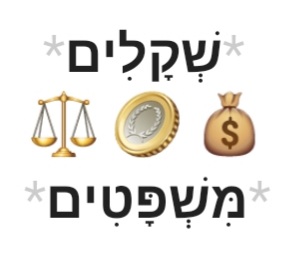This D’var Torah should be a Zechus L’Ilui Nishmas my sister, Kayla Rus Bas Bunim Tuvia A”H, my maternal grandfather Dovid Tzvi Ben Yosef Yochanan A”H, my paternal grandfather Moshe Ben Yosef A”H, my uncle Reuven Nachum Ben Moshe & my great aunt Rivkah Sorah Bas Zev Yehuda HaKohein.
It should also be in Zechus L’Refuah Shileimah for:
-My father Bunim Tuvia Ben Channa Freidel
-My grandmothers Channah Freidel Bas Sarah, and Shulamis Bas Etta
-MY BROTHER: MENACHEM MENDEL SHLOMO BEN CHAYA ROCHEL
-Mordechai Shlomo Ben Sarah Tili
-Noam Shmuel Ben Simcha
-Chaya Rochel Ettel Bas Shulamis
-And all of the Cholei Yisrael, especially those suffering from COVID-19.-It should also be a Z’chus for an Aliyah of the holy Neshamos of Dovid Avraham Ben Chiya Kehas—R’ Dovid Winiarz ZT”L, Miriam Liba Bas Aharon—Rebbetzin Weiss A”H, as well as the Neshamos of those whose lives were taken in terror attacks (Hashem Yikom Damam), and a Z’chus for success for Tzaha”l as well as the rest of Am Yisrael, in Eretz Yisrael and in the Galus.
בס”ד
For all of my audio content, please visit me at The DataBeis:
https://jewishpodcasts.fm/thedatabeis
שְׁקָלִים ● Shekalim
מִּשְׁפָּטִים ● Mishpatim
“The Best Insurance”
The mysterious series known as the “Arba Parshiyos” or the “Four Passages” begin with Parshas Shekalim. This Parsha, whose text is taken from Ki Sisa, discusses the Mitzvah of Machtzis HaShekel, or the Half-Shekel. But, why exactly is this text read at this time of year? And is there any significance to the fact that, in most years, Shekalim coincides with Parshas Mishpatim?
The simple basis for Parshas Shekalim, Chazal explain, is that at the beginning of Adar each year, this Parshas served as a public service announcement reminding everyone to pay their annual half-Shekel tax which would be collected for the communal Korbanos Tamid for the entire year in the coming month of Nissan [Megilah 3:4, 29A; Mishnah Berurah, Orach Chaim 685].
However, the Gemara [Megilah 13B] famously derives other seasonal significance for this Mitzvah, namely, that Hashem anticipated and preempted the Shekalim which the wicked Haman would eventually dish out to Achashveirosh, buying the right to obliterate the B’nei Yisrael. Apparently, the annual half-Shekel towards the communal, ritual needs served as a ransom for our souls and overrode the Shekalim of Haman. And lest one think that this tradition is a mere stretch, that is, in fact, how Parshas Shekalim describes the half-Shekel, as a “Kofer Nafsho” [Shemos 30:12] and “Kesef Kippurim” [Ibid. 30:16], literally, a “ransom of the soul” and “money of atonement.”
But, what intrinsically does the obligation of Machtzis HaShekel have to do with Haman’s plot against the B’nei Yisrael in the Purim story?
The answer, in a word, is: Community. Haman could have targeted only Mordechai, but he chose, perhaps rightfully at that moment, to lump all of the Jews in together as one collective; as a community. And when Esther marched into the palace of Achashveirosh to counteract the evil decree, she succeeded precisely in that merit, our gathering as a community [Esther 4:16].
But, what does it take to become members of a community? You “pay membership,” of course. The challenge, though, is that it is often money and finances that separate us from one another. It is a challenge because, after all, we DO need to fend for and support ourselves. But, Machtzis HaShekel is a small, financial reminder that we are a community and theref0re have spiritual, communal responsibilities and obligations. Indeed, the Korban Tamid was offered on all of our behalf, and we all have an equal portion in it. The rich don’t pay more and the poor don’t pay less [Shemos 30:15]. That is because, in the spiritual reality, there are no socioeconomic differences as all of the money of the world really belongs to Hashem [Chaggai 2:8].
Thus, how apropos it is that we often read Parshas Shekalim in conjunction with Parshas Mishpatim, the headquarters in the Torah for all monetary obligations. Some M’forshim point out [Ramban and Sforno among them] that the Mishpatim are a continuation of the Aseres HaDibros which concluded with a prohibition against being jealous to the point of compulsion of another person’s possessions. In Mishpatim, the Torah begins to define the legal scope of ownership and delineate the broader spectrum of monetary rights. And as individuals, we absolutely have to respect the each other individual’s rights to his own property. But, as owners of our assets, we have to recognize Who blessed us with them. In that spirit, beyond the standard monetary obligations that virtually all societies uphold, Hashem’s Torah assumes an elevated standard. Sometimes, we part with money and give to those in need. If we can’t give, we at least lend out the money we own. And when we do, unlike the societies of the world, we do not do so with interest. That is because the kindness and holy acts we do for members of our community do not need to be buffered by that kind of insurance. They themselves are the greatest insurance policy.
May we all be Zocheh to counteract the modern day Shekalim of every modern day Haman with our holy Shekalim by living up to the Achdus that marks our holy community of Am Yisrael and thereby be Zocheh to the ultimate Geulah with the coming of Moshiach, Bimheirah BiYomeinu! Have a Great Shabbos Rosh Chodesh Adar! 🙂
-Yehoshua Shmuel Eisenberg

